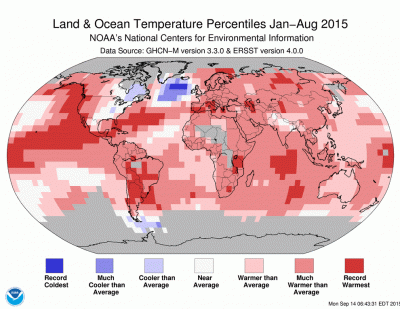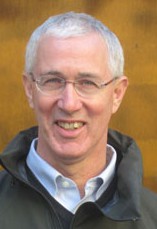There it is, hanging out in the northern Atlantic Ocean, off the southern tip of Greenland, a patch of unusually cold, fresh water in an otherwise warming, salty sea. It’s described, inelegantly, as the big, blue blob because of its color on maps of sea temperatures.
 Scientists who are studying the mechanisms behind this cooling phenomenon, suggest that ocean circulation — what they call the Atlantic meridional overturning circulation, or AMOC — in this part of the world is slowing down. And if you think of the ocean as a living organism, like a human, when circulation decreases in one part, it affects the entire system. This slowing and cooling, which some scientists say is happening decades ahead of schedule, could affect sea level rise on the East Coast, and climate patterns and marine life worldwide.
Scientists who are studying the mechanisms behind this cooling phenomenon, suggest that ocean circulation — what they call the Atlantic meridional overturning circulation, or AMOC — in this part of the world is slowing down. And if you think of the ocean as a living organism, like a human, when circulation decreases in one part, it affects the entire system. This slowing and cooling, which some scientists say is happening decades ahead of schedule, could affect sea level rise on the East Coast, and climate patterns and marine life worldwide.
Supporter Spotlight
In St. John’s, Newfoundland, Canada, at 47 degrees latitude north, professors Brad deYoung and Entcho Demirov live at the southern edge of change. “The North Atlantic is an area that is very dynamic,” says Demirov, an associate professor of physics and physical oceanography at Memorial University of Newfoundland. “You have to look at the size of the cold water spot, not just horizontally but vertically. Then we have to determine what caused it, what’s the impact and how long will it persist.”
Like many scientists, deYoung attributes, at least in part, the slowing of the AMOC and the formation of the blue blob to two main factors: freshwater flowing from a melting Greenland ice sheet and river runoff from a warmer Arctic. A similar situation is unfolding near Antarctica, where melting ice is chilling part of the ocean. This is happening even though average sea surface temperatures globally set a record high.

“We’re still disentangling climate change and other variabilities to understand what’s happening,” says deYoung, a professor in the physics and physical oceanography department at Memorial.
The ocean’s underlying mechanism is a conveyor belt of warm water that circulates from southern latitudes to the north and then returns cooler waters back toward the equator again. For example, this motion is responsible for the Gulf Stream, which flows northward off the Southeast coast before veering across the Atlantic. Its warm waters help keep Western Europe temperate even though it is located farther north than the U.S. The churn of ocean waters also fosters marine habitats for zooplankton, fish and other aquatic life.

But an influx into the ocean of cold, fresh water, which has less salt and thus is less dense, disrupts the motion and heat exchange. If that persists, over time, a lethargic conveyor belt will no longer move water. A breakdown of the Gulf Stream could translate to colder weather in Western Europe, higher sea levels along portions of the N.C. coast and changes in marine ecosystems. Some fish could die; others could migrate. And because of the interconnectedness of the ocean currents, the effects could be international in scope.
Supporter Spotlight
“We can turn off the AMO circulation by adding fresh water, which could shut it down,” deYoung says. Although that is unlikely, he adds, “It is still possible that we can substantially disrupt circulation on a larger scale in the ocean.”
“Why we care about the blue blob is that it’s occurring in an area near Greenland where the water becomes cold and dense enough to act like a drain in a bathtub for the ocean,” says Jesse Farmer, a paleoclimatologist at Columbia University who grew up surfing in Emerald Isle in Carteret County. “The Gulf Stream could get sucked into the drain, and it supplies the heat.”
A similar decline in the circulation occurred in 1969 in the Labrador Sea, just west of the current cold spot. A pulse of melt water from the Arctic diluted the surface ocean, which in turn halted deep water convection in that region. The subsequent circulation slowdown resulted in the what scientists called the Great Salinity Anomaly. The journal Progress in Oceanography used more dramatic language: “[It was] one of the most persistent and extreme variations in global ocean climate observed in this century.”
But as Michael Mann, a distinguished professor of meteorology at Penn State, and several colleagues wrote last May in Nature Climate Change, the sea and circulation recovered — but only until the early 2000s, when the Greenland again started to shed ice and ocean circulation slowed.

The disturbance in the North Atlantic could have far-reaching implications for the mid-Atlantic region thousands of miles away. Ocean circulation creates a pressure gradient that causes water to pile up on the highest areas beneath the ocean and away from the coast, explains Mann, who also runs the university’s Earth Sciences Center. If the circulation slows or stops, the pressure decreases and the water relaxes toward the shoreline.
Many scientists did not expect the recent shifts to happen so quickly. “I thought the AMOC would change slowly, but the oscillation has been quite dramatic over short periods,” deYoung says. “We like to think of climate as an elephant moving slowly along. But the ocean system is not that simple. We’re open for more surprises.”
Mann says climate models didn’t predict such a slowdown until the next century, “but it’s already happening.”

A lack of long-term historical data has hampered scientists from fully understanding the underlying causes of an AMOC slowdown. Mud core samples from the ocean floor could yield information. However, mud accumulates very slowly at those depths, making it difficult to reconstruct a timeline, Farmer says, or predict the future of the blue blob.
“It could disappear tomorrow or it could be here for 20 years,” he says.
If the blob persists, it could briefly offset some of the effects of a warming planet. However, the supply of fish, a main livelihood for many cultures in the North Atlantic, could be diminished or altered. Some species could migrate to warmer waters, or different varieties could arrive in the colder areas.
“We’re not going to get another Ice Age,” Mann says. “And it’s not going to play out on a time scale of days, but decades. But that’s pretty fast from a societal standpoint. There are challenges in adaptation. You can’t adapt when you don’t know what’s in store.”








